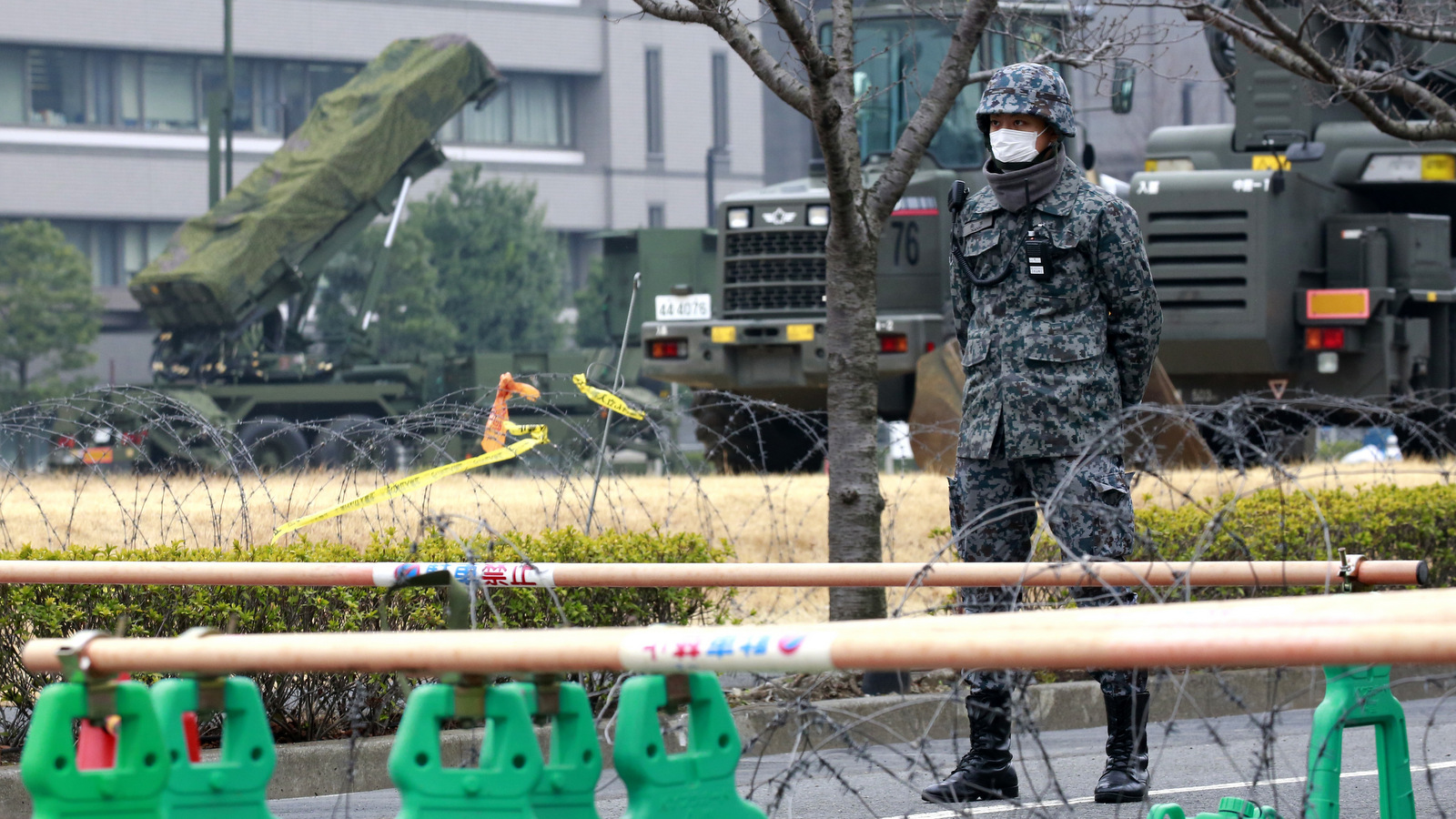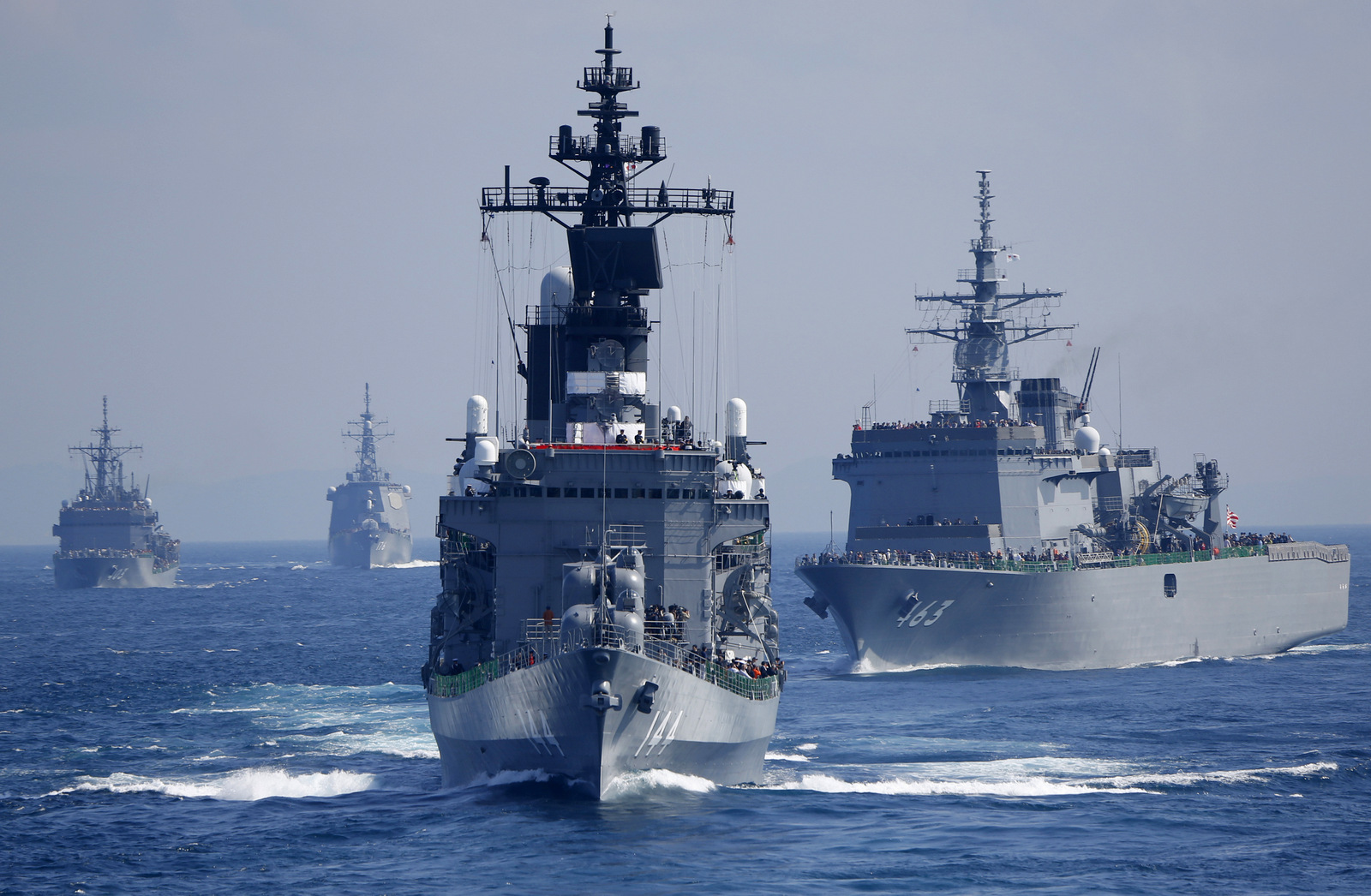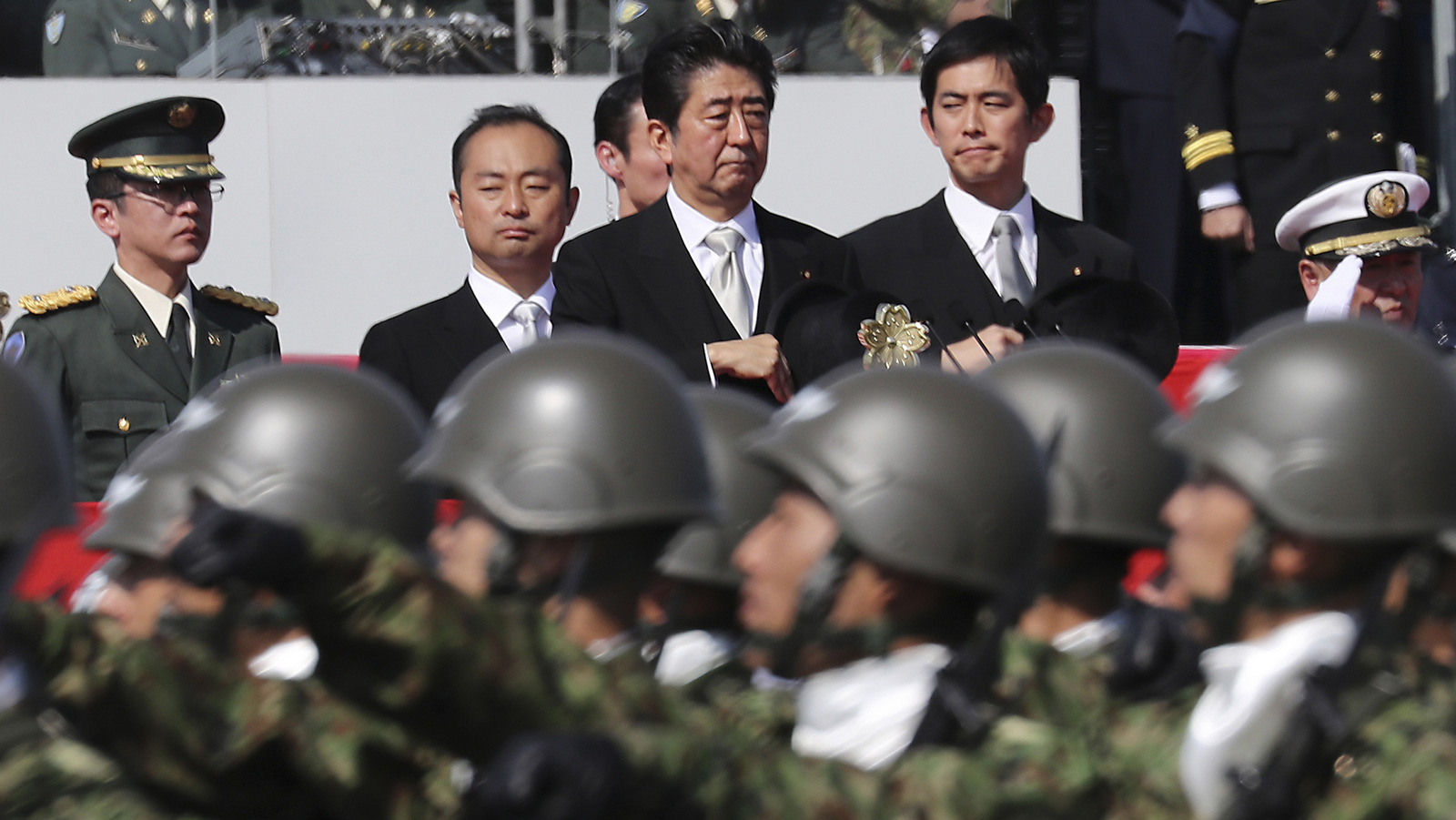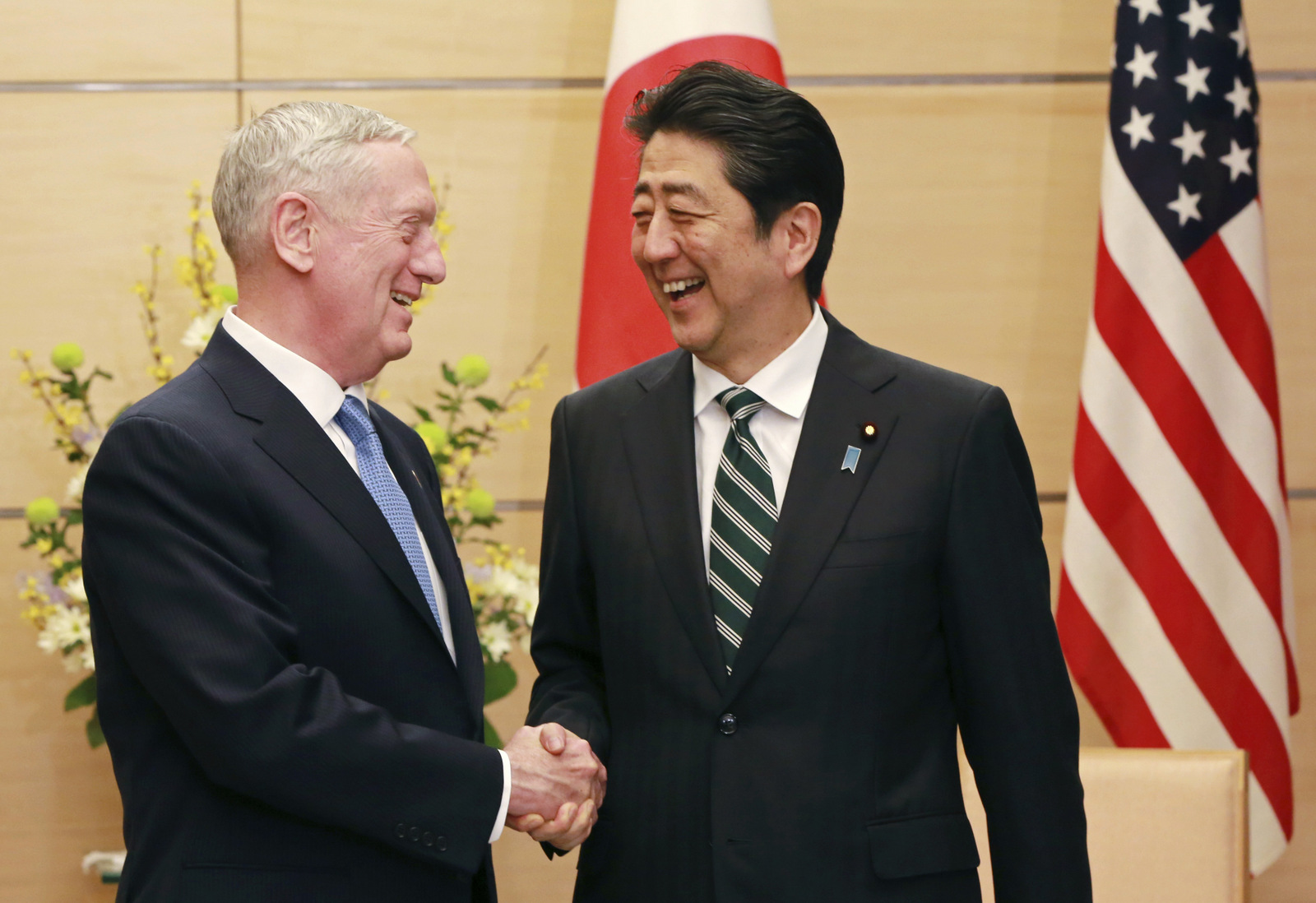
A member of Japan Self-Defense Force stands by an American Patriot missile unit deployed against the North Korea’s missile firing, at the Defense Ministry in Tokyo, Monday, March 6, 2017. (AP/Shizuo Kambayashi)
Since taking office in 2012, Japanese Prime Minister Shinzo Abe has caused a furor in the nation over his push for a stronger military that would be free from the shackles of Japan’s pacifist constitution. While Abe is technically responsible for the remilitarization of Japan, he may simply be a pawn in the U.S.-Japanese “strategic relationship” in which Japan itself is largely voiceless.
Following the post-World War II Allied occupation of the country and its near complete disarmament, Japan was all but forced to align itself with U.S. interests as it came to exclusively rely on the U.S. military for its defense. To this day, the U.S. State Department refers to the American-Japanese relationship as “the cornerstone of U.S. security interests in Asia and […] fundamental to regional stability and prosperity.”
Though the U.S. has pushed Japan to rebuild its military on more than one occasion, such as during the Korean War, it was not until recently that Japan chose to follow these suggestions. With its economy on the edge of crisis and tensions with China and North Korea growing higher, Japan has been left with little choice in the matter.
While strained relations with Beijing and Pyongyang are a clear factor, Japan’s push to remilitarize also boils down to money. Despite the nationalist sentiment behind the push to cut the pacifist clause from its constitution, Japan is actually undercutting its own arms manufacturers in favor of expanding the presence (and pocketbooks) of the U.S. weapons industry.
As Jeffrey Cavanaugh noted in a 2014 article for MintPress, the U.S. is eager “to replace the older model that kept the states of East Asia in separate security compartments all linked to Washington with something more comprehensive, like a sort of Pacific version of NATO that would bind them and Washington together in a more cohesive and comprehensive manner. […] with Japan now moving to ‘reinterpret’ those provisions in its constitution that prevent it from using force in association with military allies outside its home territory, the whole project becomes much more feasible.”
As Cavanaugh noted later, “a Japan that is a more effective partner for the U.S. is naturally a much greater danger to China than one that is hobbled by self-imposed constraints on the use of its military power abroad.”
As evidenced by the Wolfowitz doctrine that still guides much of U.S. foreign policy, as well as other statements from top U.S. powerbrokers, a major part of the U.S. plan to “engage and contain” China involves arming Japan to the teeth, while also garnering handsome profits for U.S. weapon manufacturers.
Japan develops defense industry despite drowning in debt

Japan Maritime Self-Defense Force (JMSDF) escort ship “Kurama” leads other vessels during a fleet review in the water off Sagami Bay, south of Tokyo. (AP/Shizuo Kambayashi)
While many nations find themselves struggling economically, Japan is a standout case in many ways, most notably for its massive debt. For instance, Japan has the world’s highest government debt to GDP ratio, which now stands at nearly 250 percent. In contrast, Greece – another nation drowning in debt – has a significantly lower government debt to GDP ratio of 179 percent. Japan is also saddled with an economic growth rate of near zero.
While the Japanese economy should have collapsed under the weight of its government’s massive debt by now, years of reckless money-printing, also known as “quantitative easing,” have kept the economy afloat, but barely. Members of the Bank of Japan have warned in recent years that the Japanese economy is so fragile, it could nosedive into a recession even by events as trivial as a period of bad weather. Even Japan’s scandalous adoption of negative interest rates has failed to improve the nation’s economic outlook.
When assuming power in 2012, Abe promised to revitalize the Japanese economy with a three-pronged plan now known by the nickname “Abenomics.” While it is clear to outside observers that Abenomics has done little to boost growth or improve Japan’s economic outlook, there is some evidence to indicate that Abenomics was implemented primarily to transform the country’s economy through the growth of its military-industrial complex.
As Abe’s supporters were fond of saying in the 2012 general election and after, the prime minister’s economic plan was based on “fukoku kyohei” – a Japanese phrase that translates as “enrich the country, strengthen the army.” It was Japan’s national slogan during the Meiji period, when Japan began to industrialize. According to the logic of this phrase, only a wealthy Japan can afford to defend itself.
While a “wealthy Japan” for many may invoke an image of a country where all equally partake in increased wealth that is gained through a sound economy, for Japan to increase defense spending in the short term, all its government really needs to do is print more money – which is exactly what has taken place under Abe’s watchful eye.
Abe’s true ambitions now stand out quite clearly, as evidenced by his continual push to end Japan’s commitment to pacifism, which dates back to the adoption of its U.S.-drafted constitution in 1947. Last Wednesday, Abe stated that he hopes to fundamentally alter the Japanese constitution as soon as 2020. The changes Abe has proposed would involve gutting Article 9, in which Japan renounces its right to wage war for purposes other self-defense, and enshrining the status of the military. On Tuesday, Abe called revising the constitution “the responsibility of our generation.”
Abe’s push for the end of pacifism

Japanese Prime Minister Shinzo Abe, center, reviews members of Japan Self-Defense Forces during a parade of the Self-Defense Forces Day at Asaka Base in Asaka, north of Tokyo. (AP/Eugene Hoshiko)
However, this is only Abe’s latest attempt to end Japan’s post-World War II commitment to pacifism. Abe, only three years into his term, boosted Japan’s defense spending, making its defense budget the seventh-largest in the world, despite the fact that it has no “formal” military.
That same year, Abe began to strongly push to repeal Article 9 in order to allow Japanese troops to fight in overseas conflicts, even if Japan itself is not threatened. Abe’s repeal measure came packaged with ten other security bills that were widely opposed by the Japanese people. However, that didn’t stop Abe from forcing them through parliament, which sparked fistfights and general chaos among MPs. A member of the Democratic Party of Japan said at the time that “if bills can be passed in a violent way like that, then our country’s democracy is dead.”
Watch Japanese lawmakers clash over the signing of the controversial military bills in 2015:
A majority of Japanese citizens still reject Abe’s plans for a more militarized Japan, but the gap is quickly closing. A recent Nikkei Inc/TV Tokyo poll cited by Reuters showed that 46 percent of Japanese citizens favor making no changes to the constitution, down from 50 percent last year, while 45 percent of those polled now support Abe’s proposed changes, up from 40 percent last year.
The dramatic change in Japanese attitudes toward Abe’s plan can be attributed to aggressive fear-mongering over non-existent threats like North Korea and China that have been stoked by the Japanese government and Abe himself. As MintPress previously reported, the Japanese government warned its citizens in April that they may have ten minutes or less to prepare for the arrival of a Japan-bound North Korean nuclear missile. This warning, however, only built on concerns that had been growing for months, with schoolchildren holding nuclear evacuation drills back in March.
Abe has personally helped to provoke public concern, stating last month that North Korea has the capability to deliver missiles loaded with sarin gas to Japan. The fear-mongering has worked, with sales of nuclear shelters and radiation-blocking air purifiers skyrocketing in Japan over the last month, along with more Japanese agreeing to end the country’s pacifist tradition.
Thanks to Abe’s efforts, along with the convenient emergence of greater “threats” to the Japanese homeland, Japan’s military budget this year reached a record-breaking high of ¥5.1 trillion, or $44 billion. Within the budget are plans to purchase significant amounts of defense equipment, including six new submarines, eight new Coast Guard ships and an upgraded missile defense system. At the time, the reasoning given for the massive increase in defense spending was Japan’s dispute with China over a group of uninhabited islands in the East China Sea. China refers to them as the Diaoyu Islands, while Japan refers to them as the Senkaku Islands.
Japan capitulating to domestic, U.S. military-industrial interests

U.S. Defense Secretary Jim Mattis, left, and Japanese Prime Minister Shinzo Abe, right, shake hands at the prime minister’s office in Tokyo, Friday, Feb. 3, 2017. (AP/Eugene Hoshiko)
However, Japan’s militarization has less to do with external “threats” and more to do with pleasing weapons manufacturers both domestically and in the U.S. Under Abe, Japan dropped an outright ban on selling arms abroad as increasing exports of Japanese-made arms became a key element of “Abenomics.” The move pleased Japanese arms manufacturers who were then able to sell their products in larger markets.
While Abe argued that the growth of the domestic arms industry would produce jobs and improve the Japanese economy, noted anti-war activist and author David Swanson told MintPress News otherwise.
“There is nothing defensive about these weapons, and they do not produce jobs. As the University of Massachusetts at Amherst has shown, the same money in other industries or even never taxed in the first place produces more jobs,” Swanson said.
Since 2014, Abe has shifted his focus from expanding Japan’s domestic weapons industry to making large purchases from U.S. arms manufacturers. The shift began in 2015 with the signing of the Reciprocal Defense Procurement (RDP), which opened the door to arms sales between the two nations.
Though Abe marketed the deal as another opportunity to expand markets for the Japanese arms industry – as it allowed Japanese weapons to be freed from “Buy American” laws and other protectionist provisions – the U.S. made it clear at the time that it would not be purchasing Japanese weapons. As Breaking Defense noted in its coverage of Japan’s signing of the RDP: “even setting protectionist politics aside, U.S. requirements tend to be too unique (and too expensive) for other countries’ war machines to meet.”
But less than two years later, Abe’s tone has changed so dramatically that he sounds more like a U.S. politician than Japan’s prime minister. On Feb. 15, Abe told Japan’s parliament that “Japan has introduced U.S. defense equipment using state-of-the-art technology and it is vital to our country’s defense. National security and the economy should be separated as a matter of course, but I believe that buying U.S. defense equipment will contribute to the U.S. economy and job creation.”
Abe’s statements angered Japan’s domestic arms manufacturers. A sympathetic Defense Ministry official echoed their frustration by urging Abe to “select the best equipment, regardless of whether it is made in Japan or the United States, based on cost-benefit performance.”
But Abe may be unwilling to do so, due to external pressure. As the Asahi Shimbun noted, Abe’s statements came after U.S. President Donald Trump emphasized Japan’s “continued investment in defense” at a meeting held between the two leaders just days prior in Washington, D.C.
“It is important that both Japan and the United States continue to invest very heavily in the alliance to build up our defense and our defensive capabilities, which, under our mutual leadership, will become stronger and stronger, and, as time goes by, ultimately they will be impenetrable,” Trump stated at a joint news conference held after the meeting.
While Trump did not make any specific demands, one high-ranking official at the Defense Ministry told the Asahi Shimbun, “As Japan increases defense spending, it is very likely that the United States will ask the country to buy more defense equipment.”
Now, just three months later, the Japanese government is seeking to purchase Raytheon-manufactured Tomahawk cruise missiles in order to “preemptively destroy threats,” such as North Korea’s medium-range missiles. For those who recall Trump’s recent use of the same missiles in Syria, each missile will cost the Japanese government an impressive $1 million a piece.
If the order for Tomahawk cruise missiles follows through, Japan – regardless of whether the constitutional referendum is passed – will not only help to fund the U.S. military-industrial complex, but threaten its own national security by becoming a tool of a more aggressive foreign policy that targets Beijing.
Source Article from http://www.mintpressnews.com/the-end-of-the-japanese-the-policy-of-pacifism/227711/
 RSS Feed
RSS Feed















 May 12th, 2017
May 12th, 2017  Awake Goy
Awake Goy 





 Posted in
Posted in  Tags:
Tags: 













